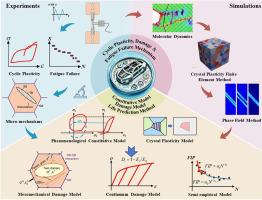镁合金的循环塑性、损伤和疲劳失效研究进展
IF 14.3
1区 材料科学
Q1 MATERIALS SCIENCE, MULTIDISCIPLINARY
引用次数: 0
摘要
镁合金以其低密度、高比强度的特点,广泛应用于工程结构的轻量化设计。然而,镁合金复杂的力学行为,特别是受位错滑移、孪晶、去孪晶及其相互作用影响的循环塑性、损伤和疲劳破坏,为确保镁合金部件的安全性和可靠性提出了重大挑战。解决这些挑战需要全面了解这些行为及其潜在的微观机制,并开发可靠的本构模型、损伤模型和疲劳寿命预测方法。本文通过详细阐述镁合金宏观塑性变形和微观机制之间的复杂联系,以及通过实验研究和数值模拟观察到的微裂纹和微孔的萌生和扩展,重点介绍了这些主题的最新进展。我们还讨论了预测镁合金循环塑性和/或疲劳寿命的理论模型的进展。最后,对今后的研究方向提出了建议。本文章由计算机程序翻译,如有差异,请以英文原文为准。

A review on cyclic plasticity, damage, and fatigue failure of magnesium alloys
Magnesium (Mg) alloys, known for their low density and high specific strength, are widely used in the lightweight design of engineering structures. However, their complex mechanical behaviors, particularly including the cyclic plasticity, damage, and fatigue failure influenced by dislocation slipping, twinning, detwinning, and their interactions, present significant challenges in ensuring the safety and reliability of Mg alloy components. Addressing these challenges requires a comprehensive understanding of such behaviors and their underlying micro-mechanisms, and the development of reliable constitutive models, damage models, and fatigue life prediction methods. This review highlights recent advancements in these topics by elaborating particularly on the intricate connections between the macroscopic plastic deformation and microscopic mechanisms of Mg alloys, and the initiation and propagation of microcracks and microvoids observed through experimental studies and numerical simulations. We also discuss the progress in the theoretical models that predict the cyclic plasticity and/or fatigue life of Mg alloys. Finally, some topics for future research are suggested.
求助全文
通过发布文献求助,成功后即可免费获取论文全文。
去求助
来源期刊

Journal of Materials Science & Technology
工程技术-材料科学:综合
CiteScore
20.00
自引率
11.00%
发文量
995
审稿时长
13 days
期刊介绍:
Journal of Materials Science & Technology strives to promote global collaboration in the field of materials science and technology. It primarily publishes original research papers, invited review articles, letters, research notes, and summaries of scientific achievements. The journal covers a wide range of materials science and technology topics, including metallic materials, inorganic nonmetallic materials, and composite materials.
 求助内容:
求助内容: 应助结果提醒方式:
应助结果提醒方式:


